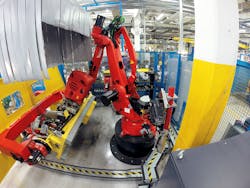If someone says the word “scooter” to you, chances are you think of the Vespa—the Italian brand scooter manufactured by Piaggio. What you might not think of is how integral advanced manufacturing technologies are to the production of this iconic product.
Daniele Landini, Piaggio Technologies manufacturing manager, says that the welding of the Vespa body is a special process and, therefore, requires extreme attention in terms of planning and implementation. “The body, after all, is the heart of a Vespa and needs the maximum attention from a technological standpoint,” he says. “This is why robotics and their subsequent reliability influence the reliability of the process.”
Describing the twin production lines, automated by Comau, which are used to produce the Vespa Primavera at Piaggio, Landini explains that each line is capable of processing more than 100 bodies during each of three daily production shifts. “More than 300 weld spots and a thousand millimeters of arc welding connect the structural parts of the Vespa to its aesthetic parts,” he says. “The welding process is automatic, leaving for workers the sole duty of loading the components and making sure that they are properly connected to the system and equipment.”
Landini says construction of the Vespa body is a complex process. “It has shapes and curves that make the execution and design of the weld spots very hard to achieve,” he says. To address this issue, when beginning work with Comau on automation of the lines, Piaggio provided Comau a decomposition of the production process as they saw it. The ability for the robots to work in the small areas of the Vespa body was a critical part of this draft description.
In the final building phase of the lines, Landini says the design of the welding guns and the correct position of the arms of the robot proved difficult to implement. “We asked Comau to find a way to accomplish what we had designed on paper. They have allowed us to give life to what was only a draft on paper, and we have cooperated with them to the last detail to accomplish what we proposed,” he says.
Conformity of the weld spots on the Vespa are dependent on the automated production sub-processes implemented by Comau during the design of the two lines, explains Landini. “We were able to obtain stable and reliable welds in way that ensures the process is constantly monitored within the context of Six Sigma,” he says.
The main role for humans in this part of the production process is in the final stage where “everything that has been done is carefully checked to make sure the aesthetic is free from any imperfection, to allow for perfect painting of every part,” Landini says.

